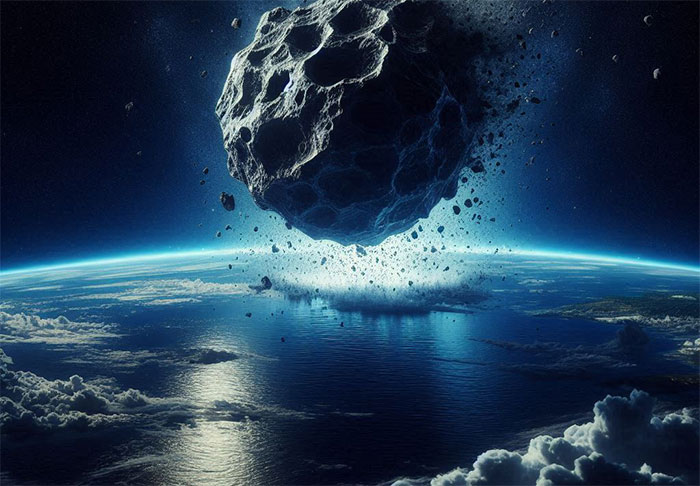'Killer number 2' secretly lands on Earth amid meteorite disaster
The mysterious object has carved a crater 8km wide into the Earth's surface and could be an "accomplice" of Chicxulub.
According to The Guardian , traces of an extraterrestrial object found on the seabed off the coast of Guinea in West Africa may be evidence that the extinction event that dinosaurs suffered 66 million years ago was not caused by the "killer" Chicxulub alone.

The Nadir impact crater may be evidence of an "accomplice" of the Chicxulub asteroid that wiped out the dinosaurs on Earth - (AI illustration: ANH THU).
About 66 million years ago, a giant asteroid called Chicxulub unleashed a force equivalent to about 1 million atomic bombs on Earth, triggering a series of catastrophic disasters that ended the planet's "monster age."
The remnants of this event are an impact crater that straddles Mexico's Yucatán Peninsula.
Now, scientists have discovered a startling truth: Dating results of an impact crater up to 8 km in diameter off the coast of West Africa show that it appeared about 65-67 million years ago.
Calculations show that it is the remaining trace of an asteroid more than 400 m in diameter, which once rushed to Earth at a speed of more than 72,420 km/h.
Dr. Uisdean Nicholson - a marine geologist at Heriot-Watt University (UK), the lead author of the study on the crater named Nadir - said scientists discovered the impact crater thanks to 3D maps created from seismic waves.
The results showed that in addition to its huge diameter, the crater was also up to 300 m deep.
These details show that the collision, although "weaker" than the Chicxulub disaster, was enough to cause violent tremors that liquefied sediments below the ocean floor, forming new faults.
The terrifying event also caused landslides with visible damage for thousands of square miles beyond the rim of the impact crater.
From there, a "monster" tsunami more than 800m high was formed and swept across the Atlantic Ocean.
Large amounts of greenhouse gases were also suddenly released into the atmosphere during the chain of disasters.
Writing in the scientific journal Nature Communications Earth & Environment, the researchers said they also suspect the space rock is a "brother" of Chicxulub.
It is possible that both objects were separated from a common "mother body ," a large asteroid that broke into many large and small pieces on its way to Earth.
- Giant meteorite approached the Earth at midnight on September 7
- Shock with the number of meteors that could hit Earth in the next 100 years
- Recreating the meteorite disaster 66 million years ago made the dinosaurs extinct
- 5 ideas to save the Earth from a meteorite disaster
- What happens when a meteorite is
- A giant meteorite just flew over Earth
- The secret of the meteorite picture falls to Earth
- Suffering from meteorite disaster but why dinosaurs are extinct, birds are not?
- A meteorite as big as the Great Pyramid is about to fly over the Earth
- Meteors approaching Earth in 2026
- NASA asked people to hunt for killer meteors
- NASA: Earth is not prevented from being impacted by meteorites
 Van Allen's belt and evidence that the Apollo 11 mission to the Moon was myth
Van Allen's belt and evidence that the Apollo 11 mission to the Moon was myth The levels of civilization in the universe (Kardashev scale)
The levels of civilization in the universe (Kardashev scale) Today Mars, the sun and the Earth are aligned
Today Mars, the sun and the Earth are aligned The Amazon owner announced a secret plan to build a space base for thousands of people
The Amazon owner announced a secret plan to build a space base for thousands of people